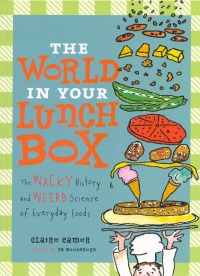| ________________
CM . . . . Volume XVIII Number 36 . . . . May 18, 2012

 |
The World in Your Lunch Box: The Wacky History and Weird Science of Everyday Foods.
Claire Eamer. Illustrated by Sa Boothroyd.
Toronto, ON: Annick Press, 2012.
121 pp., pbk. & hc., $14.95 (pbk.), $22.95 (hc.)
ISBN 978-1-55451-392-5 (pbk.), ISBN 978-1-55451-393-2 (hc.).
Subject Headings:
Food-Juvenile literature.
Food habits-Juvenile literature.
Grades 4-7 / Ages 9-12.
Review by Ellen Wu.
***½ /4
|
| |
|

excerpt:
Is your lunch dull, blah, boring? Have you seen and tasted it all before? Well, don’t give up on that sandwich yet! There might be a lot more to it than you realize.
Food doesn’t have to be fancy to be interesting. Every kind of food, no matter how basic, has ties with exciting history, amazing science, and some very strange stories. One kind of food travels halfway around the world to reach you; another comes from just down the road. Your favorite sandwich was soldier’s rations centuries ago. Your favorite fruit could come from a desert in Africa, and your favorite vegetable from a mountainside in Peru.
Wars have been fought over food. People have been killed by food or for food. Others have been saved by it. Some foods are created by complicated chemical reactions. Others create chemical reactions when you eat them.
Your job is to keep a lunch diary that track your lunch for a whole week. Then we’ll do some research and see where it takes us. I’m guessing we’ll find some prehistoric nomads, ancient tombs, explorers’ ships, maybe even a little mad science.
The World In Your Lunch Box delivers what it promises, a Mission: Delectable in which we are guided through seven days’ worth of lunchbox discoveries. Eamer and Boothroyd hit upon a winning formula, unearthing fun facts about everyday foods, and providing answers to many questions kids may never have thought about asking in the first place. When a book kicks off with a true story of a Bishop who cooked and ate his own sealskin boots, you know you’re in for quite the reading adventure.
The premise of the book is that a child (unnamed) gets assigned by their cooking teacher (also anonymous) to keep a food diary for a week, keeping an inventory of their lunches. Each day’s featured lunchbox foods, from pizza to pita, corn to ice cream, are examined from the lens of both how they were used in history, and the science behind them, too. The book runs through a whole week of lunches, and two or three food items are highlighted per day. A handy checklist at the top corner of each page shows which food item’s been covered, and what’s being highlighted next. The teacher, a gangly, good-natured cartoon character, pops in at the start of each chapter to respond to the student’s diary entries about what lunch food choices there are, and gently guides the child with tips on research. The layout of the book is eye-catching and colourful without being too busy, and there is just the right amount of text per page. You’ll get to find out what Banana Republics are and why they were named that way, the principles behind what makes foods like mustard taste hot, how mayonnaise was invented in the eighteenth century, and a special use for cloves for people to sniff during the olden days when sewage and garbage were dumped on the streets. The end of the book features a top ten list of fascinating and fun food facts (did you know honey was used to treat wounds in ancient Egypt?), a list of suggested further reading, and a bibliography.
Boothroyd’s illustrations have an irreverent humour about them, and a visual style reminiscent of Quentin Blake’s energy and goofiness, and the illustrations are paired with silly illustrated jokes and puns about the food items being described. An example: “What do you get if you throw two banana peels on the floor? A pair of slippers!” The visual silliness complements the lively text, making the already absorbing read even more palatable. The publisher chose to forego the usual suspects in information books (definitions, photographs, sidebars, graphs) thereby removing any whiffs that betray a textbook-like quality to which many information books may fall prey. The World In Your Lunch Box is a book children can read all the way through or dip in and out as they please to pick up fun food facts.
Eamer and Boothroyd’s recipe for success ultimately helps readers to not take the mundane objects in their world for granted, but rather, to instead discover within them the potential for containing surprising information. At the very least, the book provides a veritable fridge-load of trivia that so delights young readers--and would definitely inspire one to hunt up something to nibble. The World In Your Lunch Box should find a place in school and public libraries and would supplement assignments given out that may normally elicit initial groans. Point students to The World In Your Lunch Box, and a homework task may just become a mission: delectable for students, too, and introduce them to the detective work, ingenuity, and pleasures that go along with research as well.
Highly Recommended.
Ellen Wu, a recent library school graduate from the University of British Columbia, works in several municipal library systems in BC’s Lower Mainland.

To comment
on this title or this review, send mail to cm@umanitoba.ca.
Copyright © the Manitoba Library Association. Reproduction for personal
use is permitted only if this copyright notice is maintained. Any
other reproduction is prohibited without permission.
NEXT REVIEW |
TABLE OF CONTENTS FOR THIS ISSUE
- May 18, 2012.
AUTHORS |
TITLES |
MEDIA REVIEWS |
PROFILES |
BACK ISSUES |
SEARCH |
CMARCHIVE |
HOME |
